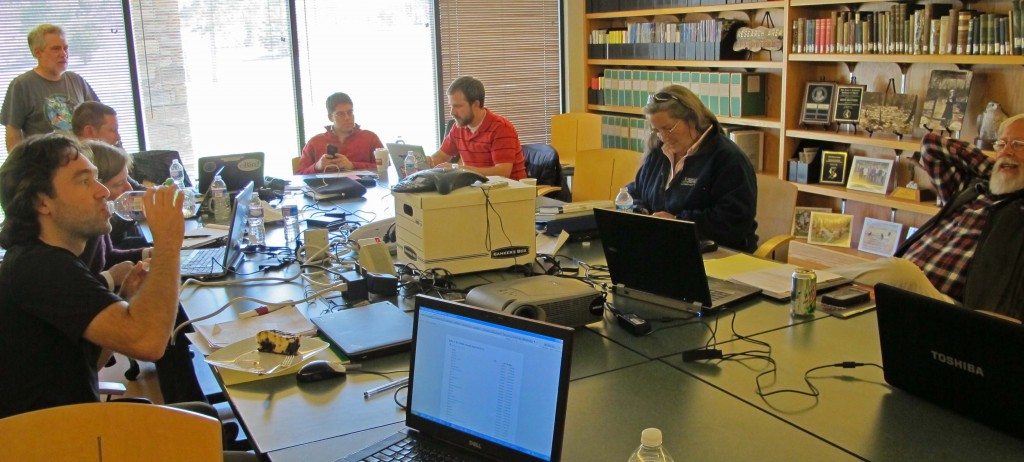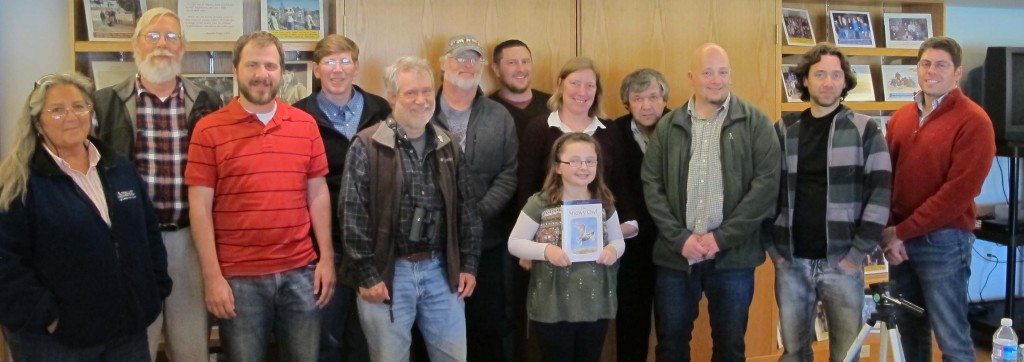
It’s not as glamorous as trapping wild owls, but the planning session this week for Project SNOWstorm was every bit as important. (©Scott Weidensaul)
Not surprisingly, we’ve been getting one question more than any other the past few weeks — what happens to Project SNOWstorm once the owls are back on the breeding grounds?
Of course, the transmitters will continue to do their job of recording GPS locations every 30 minutes around the clock, although we won’t get that data until the owl comes back south within cell range. As we’ve mentioned before, the units can store up to six or seven years’ worth of data, so we can afford to be patient.
But what about the overall project? On Thursday, all the principal players in SNOWstorm got together to work out what our next steps will be.
Jean-François Therrien, senior research biologist at Hawk Mountain, hosted the gathering at the sanctuary’s Acopian Center for Conservation Learning in eastern Pennsylvania. Folks drove in from several surrounding states, and those who couldn’t be present in person were on a speaker phone.
The in-house crowd included JF and I; Dave Brinker and Cindy Driscoll from Maryland Dept. of Natural Resources; Steve Huy (and his daughter Rowan, who helped her dad with owl trapping this winter and had the day off from school); snowy owl researcher Tom McDonald from Rochester, NY; SNOWstorm webmaster Drew Weber, down from Syracuse; Mike Lanzone and Andrew McGann from Cellular Tracking Technologies, which has partnered with us from the start to make transmitters; Mike’s wife and research partner Tricia Miller from West Virginia University, best known for her eastern golden eagle work; Russian-born snowy owl expert Eugene Potapov from Byrn Athyn College, whose recent monograph is the single most authoritative work on the species; and Doug Gross, endangered and non-game bird supervisor for the PA Game Commission, which provided early support to the project.
On the phone we had longtime snowy owl researcher Norman Smith from Massachusetts Audubon; Gene Jacobs from University of Wisconsin-Stevens Point; Frank Nicoletti from Hawk Ridge, MN; and Don Crockett from Connecticut, who created those amazing interactive maps we’ve been using all winter.

Some of the Project SNOWstorm collaborators – from left, Cindy Driscoll, Dave Brinker, Drew Weber, Scott Weidensaul, Doug Gross, Tom McDonald, Mike Lanzone, Trish Miller, Rowan Huy (with Eugene Potapov’s book), Eugene himself, Steve Huy, Jean-François Therrien and Andrew McGann (©Scott Weidensaul)
We spent many hours discussing — among many other topics — how we’d sample the nearly 100 dead snowy owls that have been salvaged in the irruption zone this winter; using stable isotope analysis to map origins and examine dietary changes over the winter; getting the nearly 1,000 owl photos that were uploaded to the website by the public categorized by age and sex, and the results mapped; and breaking down the results from this winter’s telemetry work and beginning to prepare a series of both major scientific papers and articles for the general press.
There was much more, but a central question was — where does SNOWstorm go from here?
We have a lot of potential avenues, but one thing is for sure — we’ll be tagging snowy owls again this coming winter, with a similar goal of getting GPS/GSM transmitters on 20-25 birds.
Because this will be a non-irruption year in the East and Midwest, there won’t be nearly as many owls, so that’s going to be a more challenging goal. And those that do come south will largely be second-year birds or older — an interesting contrast with the almost exclusively young owls we saw this winter. We’d expect to see some interesting differences (such as in migration timing, for example) between the age classes.
We’ll have the luxury of time to get more traditional funding sources in place for next winter’s work, but we hope that many of those who helped Project SNOWstorm this winter will contribute again next year. Perhaps the single best aspect of Project SNOWstorm was the terrific collaboration between scientists and the general public, and that’s momentum we want to keep and expand on.
———–
UPDATE: A few folks pointed out that it would have been helpful to remind supporters how they can contribute to SNOWstorm. You can make tax-deductible donations directly through the Ned Smith Center for Nature and Art, our institutional home, at http://www.nedsmithcenter.org/product/project-snowstorm-donation/.


4 Comments on “What’s Next?”
thank you from my heart—and mind!!! seeing the photos was quite wonderful…and i was proud to see both syracuse and rochester represented, since i live in syracuse. we’ll be with you no matter how you handle this…such hard work and so important. again thank each one of you. xxoo
A good looking group! Thanks so much to all of you for your hard and dedicated work this winter. It was truly a golden opportunity and you all made the best of it. The best part is that it can continue for a long time and we will learn many new facts about the Snowies.
Eugene Potapov’s Book The Snowy Owl is very good and I recommend for anyone like me that that had become interested in snowy owls.
So you believe if it’s an irruption year the second year and older birds do not come S with the first year birds?